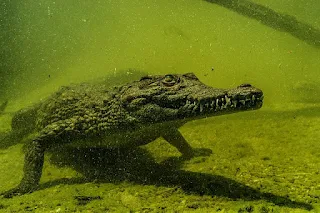Exploring the Majestic Nile Crocodile: Africa's Iconic Predator
Introduction
The Nile crocodile (Crocodylus niloticus) is a formidable symbol of Africa's wilderness, commanding both fear and fascination.
As one of the continent's most iconic predators, the Nile crocodile plays a crucial role in its ecosystem, yet various factors threaten its existence.
In this article, we delve into the world of the Nile crocodile, exploring its characteristics, behaviors, habitat, and conservation efforts.
The Nile Crocodile's Habitat and Distribution
Nile crocodiles are predominantly found in freshwater habitats across sub-Saharan Africa, from the Nile Delta to South Africa's rivers.
They inhabit various bodies of water, including lakes, rivers, and marshes, and they are remarkably adaptable to diverse environments.
From the murky depths of the Congo River to the serene waters of Lake Turkana, Nile crocodiles are masterful navigators of their aquatic domains.
Anatomy and Physical Traits
With powerful jaws, muscular bodies, and armored scales, Nile crocodiles are ideally suited for their predatory lifestyle.
Their streamlined bodies allow swift movement through water, while their formidable jaws exert a vice-like grip on prey.
These apex predators possess keen senses, enabling them to detect even the slightest movement in their surroundings—the Nile crocodile's distinctive appearance and imposing presence command respect within its ecosystem.
Behavior and Reproduction
Nile crocodiles are apex predators, occupying their habitats' highest tier of the food chain.
They are opportunistic feeders, preying on various animals, including fish, birds, and mammals.
Ambush hunters by nature, Nile crocodiles lie in wait, camouflaged amongst reeds or submerged beneath the water's surface, before launching a lightning-fast attack on unsuspecting prey.

Photo of Nile crocodile submerged
underwater, patiently waiting for prey.
During the breeding season, females construct nests along riverbanks, lay eggs, and fiercely guard their offspring until they hatch.
Human-Crocodile Conflict and Conservation
While Nile crocodiles play a vital ecological role, their interactions with humans have led to conflicts and conservation challenges.
Encroachment on crocodile habitats, illegal hunting, and retaliatory killings have threatened their populations in many regions.
Human settlements along riverbanks are particularly vulnerable to crocodile attacks, leading to tensions between communities and conservationists.
Efforts to mitigate human-crocodile conflicts and conserve Nile crocodile populations are underway.
Conservation organizations work tirelessly to raise awareness about the importance of these apex predators in maintaining ecosystem balance.
Through community engagement, habitat protection, and education initiatives, strides are being made to safeguard Nile crocodiles for future generations.
Conclusion
The Nile crocodile symbolizes Africa's untamed wilderness, embodying nature's beauty and brutality.
This apex predator commands reverence and respect due to its ancient lineage and crucial role in ecosystem dynamics.
However, human activities imperil the Nile crocodile's survival, necessitating concerted conservation efforts to ensure its continued existence.
As stewards of our planet, it is our responsibility to coexist harmoniously with creatures like the Nile crocodile, recognizing their intrinsic value in the intricate web of life.
By fostering a deeper understanding and appreciation for these majestic predators, we can work towards a future where humans and crocodiles thrive in balance with nature.
Frequently Asked Questions About the Nile Crocodile:
What is the size range of Nile crocodiles?
Answer: Nile crocodiles can vary in size, with adult males typically reaching 16 to 20 feet (4.9 to 6.1 meters) and weighing between 500 and 1,650 pounds (225 to 750 kilograms). Females are generally smaller, averaging around 10 to 13 feet (3 to 4 meters) in length.
What do Nile crocodiles eat?
Answer: Nile crocodiles are opportunistic predators, feeding on a wide range of prey, including fish, birds, mammals, and occasionally other reptiles. They are ambush hunters, lying in wait near the water's edge before launching surprise attacks on unsuspecting animals that come to drink or swim.
How long do Nile crocodiles live?
Answer: Nile crocodiles have a long lifespan, with individuals in the wild typically living between 70 to 100 years. However, factors such as habitat degradation, hunting, and human-wildlife conflicts can significantly impact their longevity.
Are Nile crocodiles dangerous to humans?
Answer: While Nile crocodiles are responsible for attacks on humans, they generally avoid confrontation unless provoked or defending their territory. Human-crocodile conflicts often occur near water bodies where people and crocodiles share habitats, highlighting the importance of caution and awareness in crocodile-prone areas.
Do Nile crocodiles hibernate?
Answer: Nile crocodiles do not hibernate in the traditional sense. Instead, they undergo dormancy periods during cooler months when water temperatures drop, reducing their metabolic rate and activity levels. This behavior helps conserve energy during times of reduced prey availability.
Can Nile crocodiles live in saltwater environments?
Answer: While Nile crocodiles primarily inhabit freshwater habitats, they can tolerate brackish water and occasionally venture into estuaries and coastal areas. However, they are not adapted for prolonged saltwater exposure and typically prefer freshwater environments for breeding and hunting.


Comments
Post a Comment